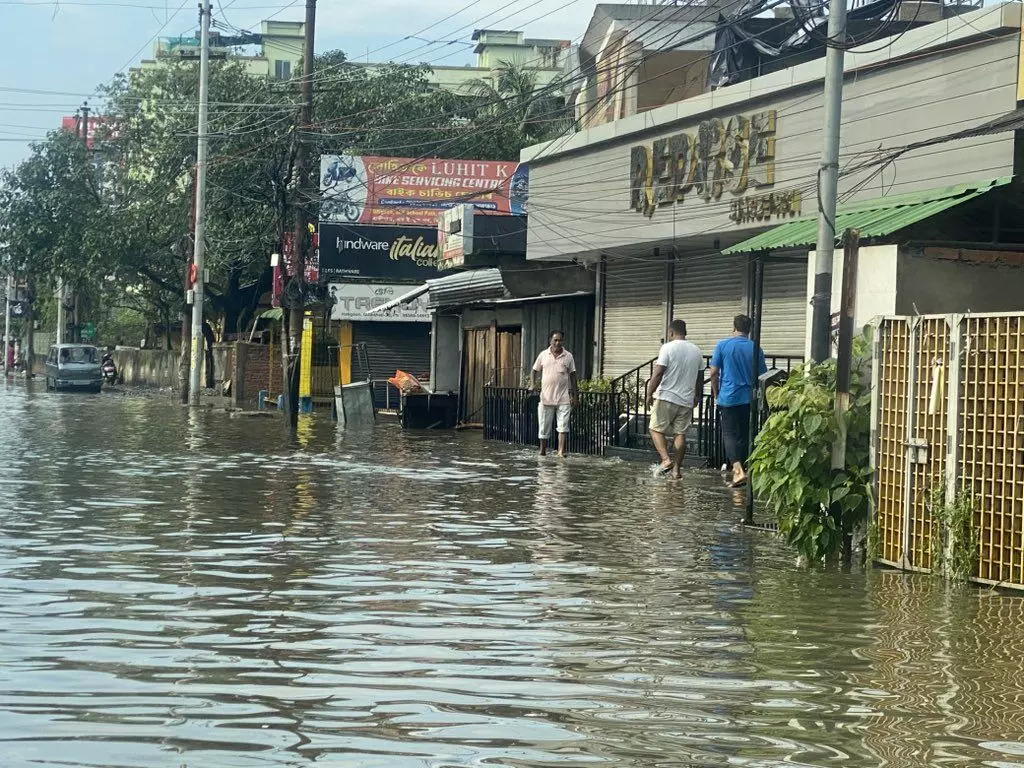Experts urge scientific solutions over rhetoric to tackle Guwahati's urban flooding
One of the proposals discussed included constructing large underground storm water reservoirs beneath existing structures and complexes.

Guwahati inundated with incessant rainfall on May 30. (Photo: AIR)
One of the proposals discussed included constructing large underground storm water reservoirs beneath existing structures and complexes, aimed at protecting vulnerable areas from heavy rainfall-induced flooding.
The colloquium was convened by senior citizens Nazibuddin Ahmed, Mrinal Gohain, and Khanin Talukdar. Key speakers included former Brahmaputra Board Chief Engineer Dhruba Jyoti Borgohain, former Water Resources Department (WRD) Chief Engineer Prasanta Dutta, NHPC Senior Technical Consultant Abu Nasser Mohammad, and former GMDA Town Planner Dalim Gogoi.
Initiating the discussion, Khanin Talukdar highlighted the city’s original master plan and noted that Guwahati once had nearly 300 wetlands - not so long ago - when it was transitioning from a town to a city. He called for a holistic approach supported by sufficient budgetary allocations and meaningful stakeholder consultations.
Dhruba Jyoti Borgohain identified multiple factors behind the city’s flood woes, including a sharp decline in green cover, rampant unplanned construction, and lack of serious commitment to tackling the issue. He also cited poor solid waste management leading to clogged drains, hill erosion, and widespread encroachment on wetlands and natural drainage channels.
He noted that flash floods occur when the city receives rainfall of just over 44 mm. Citing a study by the North Eastern Space Applications Centre (NESAC), Borgohain said 73% of Guwahati is minimally affected by flash floods, 7% faces low flooding, 8% experiences high flooding, and 1% is severely impacted.
While total elimination of flash floods may not be feasible, Borgohain stressed that mitigation is possible through better urban planning, inter-basin water transfer, and restoration of the city’s natural stormwater retention systems.
Prasanta Dutta emphasized the need for the city’s drainage system to handle at least 48 cumecs (cubic metres per second) of stormwater. Agreeing with Borgohain, he described the current pumping of floodwater via the Bharalumukh sluice gate as a mere temporary relief. Instead, he recommended enhancing the drainage capacity of Deepor Beel and the Mora Bharalu branch, as well as widening the culvert beneath the rail tracks in the Guwahati Club–Ambari area.
Dutta stressed that protecting and clearly defining the city’s natural water bodies and channels, including Bondajan, Silsako, Solabeel, Bahini, Bharalu, Mora Bharalu, Basistha, Pamohijan, and Deepor Beel, are essential. He also advocated for a single monitoring agency to coordinate and oversee the efforts of all concerned departments.
Abu Nasser Mohammad proposed building large underground storage tanks with a capacity of up to 70,000 cubic metres. He suggested locations such as the AIDC campus and the Khanapara playground of the Veterinary College as potential sites.
Dalim Gogoi noted that the city’s 1971 drainage master plan had identified six major drainage basins but was never implemented. He warned that inaction on the WRD’s proposed project to divert stormwater runoff to the Kulsi River via Dora Beel could pose a future threat to the Lokapriya Gopinath Bordoloi International Airport.
Also speaking at the event were Dr Avijit Sarma, Professor at the Indian Institute of Bank Management (IIBM), Guwahati; Senior Urban Planning Consultant Urmi Borgohain; and journalist Nayanjit Bhuyan.
Ajit Patowary
